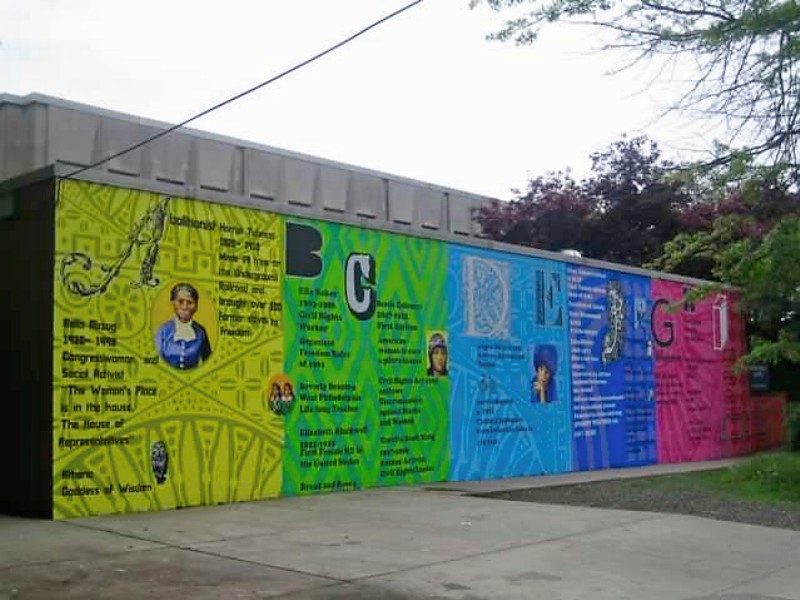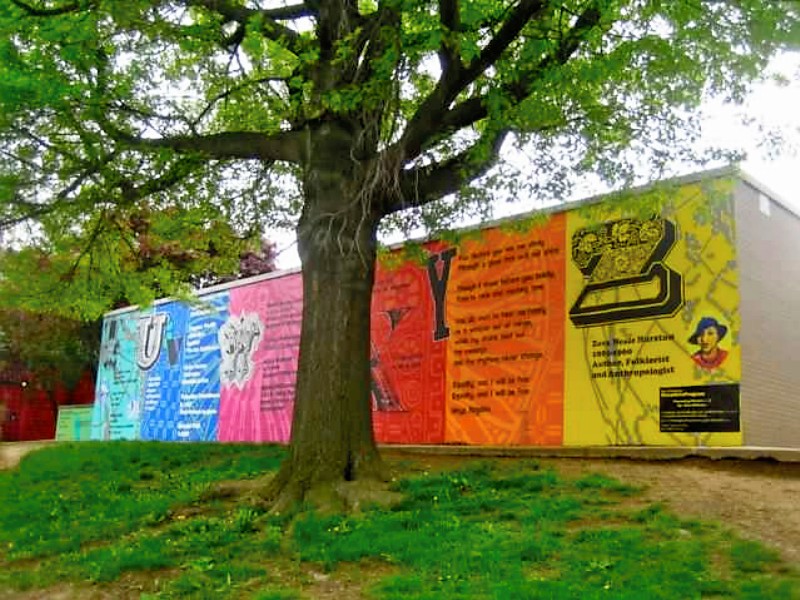Serendip is an independent site partnering with faculty at multiple colleges and universities around the world. Happy exploring!
Walled Women



POST YOUR THOUGHTS HERE
Welcome to the on-line conversation for Women in Walled Communities, a cluster of three courses in a new 360° @ Bryn Mawr College that focuses on the constraints and agency of individual actors in the institutional settings of women's colleges and prisons.
This is an interestingly different kind of place for writing, and may take some getting used to. The first thing to keep in mind is that it's not a site for "formal writing" or "finished thoughts." It's a place for thoughts-in-progress, for what you're thinking (whether you know it or not) on your way to what you think next. Imagine that you're just talking to some people you've met. This is a "conversation" place, a place to find out what you're thinking yourself, and what other people are thinking. The idea here is that your "thoughts in progress" can help others with their thinking, and theirs can help you with yours.
Who are you writing for? Primarily for yourself, and for others in our cluster. But also for the world. This is a "public" forum, so people anywhere on the web might look in. You're writing for yourself, for others in the class, AND for others you might or might not know. So, your thoughts in progress can contribute to the thoughts in progress of LOTS of people. The web is giving increasing reality to the idea that there can actually evolve a world community, and you're part of helping to bring that about. We're glad to have you along, and hope you come to both enjoy and value our shared explorations. Feel free to comment on any post below, or to POST YOUR THOUGHTS HERE.

Silence in listening
I was really intrigued this past week by Jen Rajchel's visit, especially the silent exercise that she led us in, "Tattoo Parlor". It was a really cool way to learn more about Sasha, and to think about what kind of visual image would best represent her, and so I enjoyed it from a playful (ha) perspective. But I also think that it correlates more fully to my ideal of silence--one in which you spend time actively listening to another person, to music, to the world around you--and not so much focused just on not talking. I don't mean to say that I think the silences that we have started (or ended, in some cases) our class with have not been valuable, just that I appreciate that we are moving beyond the notion that everyone must refrain from speaking for it to be a "real" silent activity.
My word this week from our exercise at the Cannery was "listen". I really value it when others actively listen to me, and I am working on becoming the best listener that I can be, with my friends, family, the larger world (BMC and otherwise), and even myself, and listening to my own needs. I really enjoyed the teaching exercise that my group planned in Jody's class on Thursday, encouraging people to partner up and listen silently while another person told a story about their adolescence. These kinds of exercises can help us all become better listeners, and truly engage in what our partner is saying, similar to in the Tattoo Parlor game.

Procrastination turns to productivity and deep reflection on the incarcerated/lifers
Yesterday morning I woke up prepared to do work...sike. I ended up wacthing a few shows and then I stumbled upon a documentary entitled The Falling Man. For my vision post, I wanted to share a journal entry I wrote right after watching it.
Dear 360 Vision Journal,
After two hours spent aimlessly searching the web for something to watch, luck would have it that I would come across a documentary on Hulu.com entitled, The Falling Man. In the context of the horrific events that happened on September 11, 2001, the documentary explores the mixed public responses and the story of a man who is headed 100 stories to his death from the World Trade Tower. As I tearfully watched the falling man’s picture, heard his stories and digested the public’s disgust and seemingly justified ignoring of the cohort 200-something individuals who plummeted to their deaths, I couldn’t help but think about my experience with the 360/women of the Cannery.
separating church and school
The thing that struck me most about the last reading was the writer's devotion to God and how she understood this devotion to be essential to learning. I'm so used to "separation of church and state" that being asked to "pray" as part of our class on Thursday caught me off guard. As someone who is not religious, I wasn't really sure how to pray or what to expect in response if I don't believe there is a God. At one point she discusses how difficult it is to learn from text alone rather than a teacher and says "yet I suffered these trial most gladly for the love of learning. Oh, if only this had been done for the love of God, as was rightful, think what I should have merited!" (53). I think this is so interesting because the general message I receive on Bryn Mawr campus is that learning for the sake of learning is one of the best/most admirable attitudes to have, but the writer of this piece is left feeling guilty for her personal love of learning because she feels as though she is being selfish and giving proper respect to God. The writer's tone of humility or even unworthiness also struck me; she states "all that I have said can do no more than other that letter to you in recompense for the failure to apply myself which you must have inferred (and reasonably so) from my other writings." (45) I wonder if this tone has to do with her religious beliefs, or her gender. From what I gathered, she seemed highly educated and this was written at a time when women didn't have much access to education.

The Self, the Other, the Silence
"Competing tendencies reside in a state of simultaneity: they are always at the same time separate and united, this and that...the Self is always at the same time both itself and other"-George Kalamaras
During our last silence exercise of our class this past week, I found myself pushing back on the silence. I found myself constantly wanting to analyze and critically think of Kalamaras' words in relation to silence. I found myself asking: "What is the goal of silence and how much of how silence is perceived, fueled by the "other" that the self "competes" with in a state of simultaneity?" I then found myself wondering whether the individual self has as much to do with how his/her silence is perceived. Can the self manipulate his/her environment in order to fuel her silence in a positive way? if so, what is necessary for this to happen?

1968 Bryn Mawr Campus Tour
Since we're having trouble uploading our Virtual Tour video, we will be posting the research so you can get an idea of what the tour will look like. I'm pretty sure we'll be showing it in class.
360 VISION RESEARCH PROJECT: 1968 TOUR OF BMC/SOCIAL CLIMATE
By Esty & Chandrea
Here is where we can start to compile our information and the resources we use!
Project focus: Campus tour/map with a focus in 1968. Perry House and Batten do not exist at that time. So we could focus on the campus and social climate for the tour--it was HOT!
Areas of interest on dorm and campus life (guide questions/FAQs on tours?):
Why don’t we have sororities?
What affinity groups existed during this time period?
What were some popular activities?
What was the most common major?
What did the campus look like?
How did customs and other dorm supports function?
What historical events coincided and/or preceded--therefore, influencing--the 60s/70s
What slang was used so we look authentic?
What do students do for fun?
What religious services are available?
Information (Jotted Notes):
General/historical/big picture context:

Religious silence
In our last class I was very struck first by our readings, and then by the last part of our class. It was the first time that I realized the difference between how Quakers and Catholics pray. When I go to church, it is usually accompanied with music, sermons, speeches, and lectures and just words in general. Words words words. Music music music. Even in silent prayer we're not silent because the priest leads us. This is very different from our practice on Thursday where we were each in charge with connecting with whatever it is that we wanted to connect with it. I find it very interesting that the Quakers sit in silence and wonder what such spiritual experience would feel like, to be in charge of making your own connection with God.
Jody's assignment
Sasha, Jomi, and I made a prezi about a timeline of the history of African American students at Bryn Mawr. We also have a physical timeline that we will bring to class Tuesday: PREZI

also some quotes
...from yesterday that I don't want to forget:
"Just because they have life doesn't mean their life stops."
"What do I get by telling others that they are stuck?"
"Nobody's homework is done."

McBride Scholars: “Finally it’s my turn and I want the best education I can have”
“Finally it’s my turn and I want the best education I can have”
In thinking about Bryn Mawr’s campus, it becomes obvious that many small communities exist within our walled community. Communities consisting of students of color, international students or students from the same area. An important community within Bryn Mawr is the Katharine E. McBride Scholars Program or McBride Scholars for short. They are women, twenty four or older, who did not complete their college education after high school for one reason or another. Bryn Mawr looks for non-traditionally aged students that exemplify intelligence, talent and achievement. These traits may be displayed through volunteer work, their jobs or some form of formal study. What separates McBride scholars from many traditionally aged students are their life experiences. Many of the women have family commitments such as children and aging parents or full time jobs. Some have put their education on a hiatus due to financial reasons or simply because of life and the tribulations it can bring along.

Maid in Silence: The Hidden History of Bryn Mawr's Housekeepers
I realized that by including my paper via attachment (because of picture issues), I wasn't creating a searchable document. So here it is in the best form I could get. The first picture is cut off on the side for some reason. Please follow links to see whole picture.
Maid in Silence: The Hidden History of Bryn Mawr’s Housekeepers

Crime and Punishment at Bryn Mawr College
How are you coming to understand women’s prisons and colleges as similar and/or different?
When I first started researching for this project, I was going to study crime and punishment at Bryn Mawr, specifically rape culture at Bryn Mawr, and how victims and perpetrators of rape at Bryn Mawr have been treated and characterized in the history of the school. Given that Bryn Mawr is an all female institution of higher education, both cloistered in terms of gender and in terms of physical space, and taking into account recent conversation about how Bryn Mawr takes a caretaker role in its treatment of its female students, I thought this to be a very interesting topic to discuss in relation to the overarching topic of women in walled communities. However, as I conducted my research I realized that in order to really get an understanding of this I would have to get first hand accounts of incidents of rape in the history of the college as well as interview campus safety officials about their experiences with rape cases on campus; the aforementioned would be difficult given the lack of voice on the issue of rape among women in earlier times and the latter would require IRB approval. Given the time for this project, I realized this would not be possible.

thoughts about "How Offenders Transform Their Lives"
The reading “How Offenders Transform Their Lives” kept reminding me of our discussion in Voice class today about GirlTime. Someone in class brought up how self-congratulatory many of the people in charge seemed about the program, and how that was a negative aspect because it seems to eliminate possibilities for the program to effectively critique itself and become better for the girls it was attempting to change. In addition, it was brought up that the program was supposed to be for those girls, not necessarily for the volunteers involved. However, I also thought that the reverse would have been equally negative, if not worse. If the women (teacher-artists) had maintained the position that they were the authority and the program had no effect on them, they would have reinforced a sense of hierarchy, a separation between the girls and their more “enlightened” positions. Positioning themselves as authority figures, they would have continued to perpetuate the sense that there was a fundamental difference between themselves and these girls. Doing this places even more importance in their authority, the necessity of having someone “in charge” who by the nature of their position, knows more than those they are intending to change. It sets up a dynamic of us/them, perpetuates the “normal” vs. “other” attitude that can be so damaging to how people chose to live their lives.

Labeling Clients and education
Just thoughts. Really incoherent thoughts:
I'm thinking about the "How Offenders Transform Their LIves" reading in a pedagogical frame. It's hard. Here these counselors are--trying to help out these "clients" by ways of telling them to "look inside themselves" to see whether or not they've "changed". But at the same time, these offenders want guidance--want people to give them a go and label that says that they're going to be okay or on the road to being delabeled. In other words, how do you guide people while still empowering them?
Quote:
"'Readiness' is clearly a complicated negotiation between clients and counselors. Clients are told that the change has to happen from within themselves, yet client self-declarations of 'being ready' are not enough to quality as evidence of success." (Shadd Maruna, Thomas P LeBel, Michelle Naples and Nick Mitchell)
Maybe my problem with their analysis is the issue that the counselors seem to be having in attempting to assist these inmates: Isn't it a problem that we're solely concerned with the labels being imposed onto the offenders? Sure, they're the ones who we are mainly concerned with, but to identify what titles they place on the counselors would 1) reveal what issues they may have with the process of being "readied" and 2) in a way, give them a place to actually label others/give them a place to become more confident in their own abilities.
This is a little too short. I'll come back to this.

Photography as a metaphor
In Chapter 7 of the Little Book of Contemplative Photography, “Making Meaning”, Zehr talks the active nature of “receiving” in photography. He calls the still, non-contextualized image of a photo, chaos, and the photographer/interpreter is responsible for creating order/coherence. It is we who, frame, organize, and make meaning of the images we choose to photograph. This, of course, is a metaphor for our experience of the world. The objective world, although it does have its own functional order, does not have “meaning” without the imposition of human perspective. Is it an empowering concept—that people can decide what meaning they will derive from the world? We all do it, but we don’t all consciously or actively do it. It echoes this speech by David Foster Wallace called This Is Water, in which Wallace says that the value – the real value -- of our liberal arts educations is that we are given the tools to escape our crippling solipsism and – our lens of selfishness, and apply new, healthier, more productive lenses. Thus, in situations which inconvenience us, we can choose how to interpret them, and thus, how to react.
The troubling thing is, not everyone can have a liberal arts education. Now everyone can take photos or make art. So how do you teach someone to feel empowered, independent, and autonomous about their lives and their ability to control and interpret their experiences? Especially when they are so systemically degraded…

Silence in Our Silence Class
Since I won't be in class this Thursday I am posting what I would (or let's be serious) would NOT have contributed to class. Anne asked me to post about what I would say in class and I don't know why I'm so nervous writing this. I think it's a combination of things that we've been discussing in class: silence, inaccessibility, language, taking risks. I just read the Kalamara's reading and I don't know if I fully understood it. There were parts of it that I would like to discuss because I felt like I could relate to it, but I'm nervous to discuss it here because I don't have the opportunity to hear other people in our class talk about it first so I can decide whether or not I actually got the point of the reading. It seemed fairly accessible to me until it brought up eastern religions and then I got confused. I don't get the feeling that this article was supposed to be as dificult to read compared to the other inaccessible readings we read together in class but I started to lose my understanding of the reading towards the end. Because I finished reading the article in a confused state, I am hesitant to explain how I understood it. What if I read it all wrong?! Perhaps this is a situation in which I realize that the little inaccessible parts of some of the readings we are assigned lead to me not contributing in class. I don't want to complain about it - I just choose to shut up.

Memo #2: Religion in Prisons
I explored the reasons behind and issues that complicate the dissemination of religion in prisons. Both images show examples of religious activity by incarcerated individauls.






